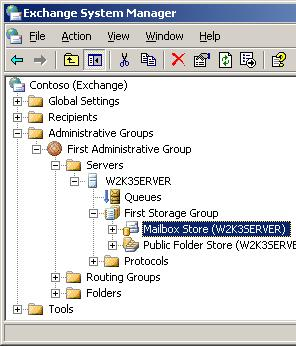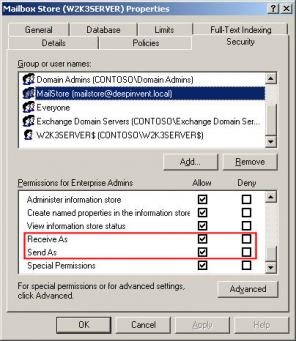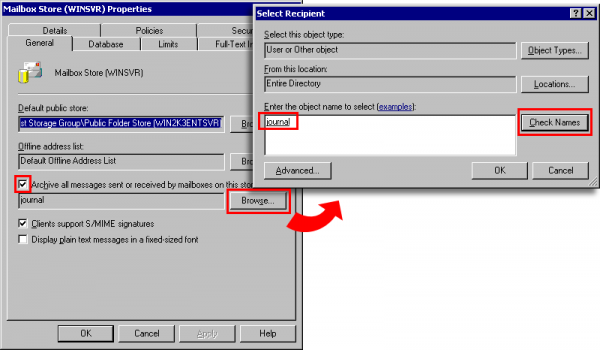Difference between revisions of "Archiving Emails from Microsoft Exchange 2003"
| [unchecked revision] | [unchecked revision] |
| Line 55: | Line 55: | ||
== Public Folders == | == Public Folders == | ||
No changes to you Microsoft Exchange Server are required to archive Public Folders with MailStore. | No changes to you Microsoft Exchange Server are required to archive Public Folders with MailStore. | ||
| + | |||
| + | [[de:Microsoft_Exchange_2003]] | ||
Revision as of 08:15, 19 May 2010
Creating a Central User to Access Mailboxes
With MailStore, some or all mailboxes of an Exchange server can be archived in a single step. All necessary preparations, such as creating MailStore users, can be made automatically. The archiving process can be executed manually or automatically according to a schedule.
Before the archiving process can be set up in MailStore, a user with access to all mailboxes to be archived has to be created.
Important notice: Microsoft Exchange Server 2003, Service Pack 2 (SP2) is required.
- Create user with full access to all mailboxes. This user does not have to have his or her own Exchange mailbox.
- Start the Microsoft Exchange System Manager. It is generally located in the Start menu under Microsoft Exchange | System-Manager.
- From the tree structure, select the appropriate Exchange server, the storage group (e.g. First Storage Group) and the mailbox store.
- Right-click onto the mailbox store and select Properties. Click on the Security tab.
- Click on Add to add the new MailStore user and grant the Send As and Receive As permissions by marking the appropriate checkboxes.
Setting Up Journaling
Before the archiving process can be set up in MailStore, Journaling has to be set up for the Exchange server. Please proceed as described below:
Step 1: Activating Envelope Journaling
Please note: Envelope Journaling is first available for Exchange 2000 Server with Post-Service Pack 3 and Exchange Server 2003 with Service Pack 1.
Start MailStore Client and log on as MailStore administrator. Click on Management Shell and enter the following command:
exejcfg
The Envelope Journaling feature in Microsoft Exchange is now activated. After pressing Enter, a success message should appear on the screen:
Successfully ENABLED Envelope Journaling for COMPANY
Step 2: Creating a Mailbox for Journaling
Create a new user whose Exchange mailbox is to be used for Journaling. Through the console Active Directory Users and Computers, add a new user with a meaningful name, e.g. journal.
Step 3: Configuring the New Mailbox as Journal Mailbox
Open the Exchange System Manager. In the tree Server, open the server name as well as the first storage group. Right-click on Mailbox Store and select Properties.
The dialog window Mailbox Store Properties opens:
- Mark the checkbox Archive all messages sent or received by mailboxes on this store.
- Click on Browse.
- Enter the name of the new user, e.g. journal.
- Click on Check Names. The name will be underlined and provided with additional information.
- Click on OK.
- In the Properties dialog window, click on OK again.
Please keep in mind that in complex Microsoft Exchange environments it may take a few minutes until the Journaling settings become active.
Important notice: Before MailStore can access the new Journal mailbox for archiving, it may be necessary for you to log on to this mailbox once using Outlook Web Access (OWA), for example.
Public Folders
No changes to you Microsoft Exchange Server are required to archive Public Folders with MailStore.



